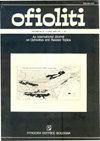希腊北部格拉莫斯-芳烃区蛇绿岩:地质、古生物和地球化学资料
IF 1.3
4区 地球科学
Q2 GEOLOGY
引用次数: 12
摘要
grammos - arenes蛇绿岩产于东临品多斯弗莱施和西临中希腊盆地之间,代表了希腊品多斯蛇绿岩带的最北端。对亚蛇绿质混杂岩关键露头的野外考察和取样,提供了有关海洋化时代和喷涌产物地球化学的新资料。玄武岩样品显示N-MOR亲和关系,与巴约世-早Bathonian放射虫岩有关。蛇绿岩侵位到大陆边缘之前,蛇绿岩物质在面向蛇绿推覆体推进的盆地中大量流动沉积。早白垩世渤天单元和第三系品多斯复理石上部深水沉积中发现了蛇绿岩碎屑流沉积和滑块。蛇绿质物质的插补首先出现在比奥提弗莱石中,之后出现在品多斯弗莱石中,这被解释为蛇绿质推覆体的前身,蛇绿质推覆体东起瓦尔达尔洋,西侵亚德里亚大陆边缘。收集到的数据可以巩固对Pindos-Grammos地区蛇绿岩侵位时间和机制的限制。此外,考虑到格拉莫斯-阿雷尼斯地区构造叠层的几何形状和所涉及的沉积矿床的年龄,有可能重建一个与沿迪纳尔-希腊链研究的其他地区相当的地球动力学历史。本文章由计算机程序翻译,如有差异,请以英文原文为准。
OPHIOLITES FROM THE GRAMMOS-ARRENES AREA, NORTHERN GREECE: GEOLOGICAL, PALEONTOLOGICAL AND GEOCHEMICAL DATA
The Grammos-Arrenes ophiolites crop out between the Pindos Flysch to the East and the Meso-Hellenic basin to the West and represent the northernmost exposure of the Pindos Ophiolite belt in Greece. Field work and sampling on key outcrops of the Sub-ophiolitic Melange provided new data on the oceanization age and on the geochemistry of the effusive products. The basalts samples show a N-MOR affinity and are associated with latest Bajocian-early Bathonian radiolarian cherts.
Emplacement of the ophiolites onto the continental margin is preceded by mass flow deposition of ophiolitic material in the basins facing the advancing ophiolitic nappe. Ophiolite-bearing debris flow deposits and slide blocks are recognized in the Early Cretaceous deep water sediments of the Beotian Unit and in the upper portion of the Tertiary Pindos Flysch. The intercalations of ophiolitic material in the Beotian Flysch first, and in the Pindos Flysch, later, are interpreted as the forerunners of the Ophiolitic Nappe which derived from the Vardar Ocean to the east, and was emplaced westwards onto the Adria continental margin.
The collected data allow consolidating the constraints for the timing and mechanism of ophiolite emplacement in the Pindos-Grammos area. In addition, taking into consideration the geometry of the tectonic stack in the Grammos-Arrenes area and the ages of the involved sedimentary deposits it is possible to reconstruct a geodynamic history comparable to that of the other zones studied along the Dinaric-Hellenic Chain.
求助全文
通过发布文献求助,成功后即可免费获取论文全文。
去求助
来源期刊

Ofioliti
地学-地质学
CiteScore
2.40
自引率
7.70%
发文量
1
期刊介绍:
Since 1976, Ofioliti provides an international forum for original contributions and reviews in the field of the geodynamics, petrology, geochemistry, biostratigraphy, stratigraphy, tectonics and paleogeography applied to ophiolitic terrains and modern oceanic lithosphere, including their sedimentary cover. Studies of topics such as geodynamics of the mantle, the evolution of orogens including ophiolites and paleoceanography are also welcome
 求助内容:
求助内容: 应助结果提醒方式:
应助结果提醒方式:


